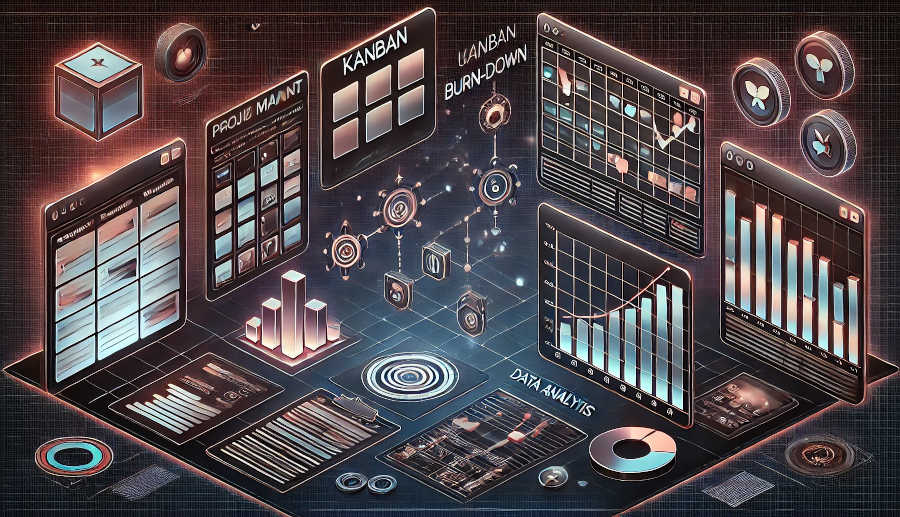A Gantt chart is a visual representation of a project schedule. It provides a clear overview of the start and end dates of various tasks, their durations, and dependencies. The horizontal axis typically represents time, while the vertical axis lists the tasks. Each task is depicted as a bar, with the length of the bar corresponding to its duration. This simplicity makes it an invaluable tool for project managers and stakeholders alike.
By using a Gantt chart, project teams can easily identify the critical path of a project. The critical path consists of tasks that, if delayed, will directly impact the project's overall completion date. This knowledge allows for focused attention on these key tasks, ensuring that resources are allocated appropriately to prevent any delays. Moreover, Gantt charts can be used to communicate the project plan to all relevant parties, from team members to senior management. Everyone can quickly grasp the sequence of tasks and the timeline, promoting better collaboration and coordination.
In addition, Gantt charts can be updated in real-time as the project progresses. Any changes in task durations, start or end dates, or dependencies can be reflected immediately. This dynamic nature enables project managers to adapt to unforeseen circumstances, such as resource shortages or changes in client requirements. It provides a live snapshot of the project's status, allowing for timely decision-making to keep the project on track.
Identifying Project Objectives and Criteria
Before using a Gantt chart to prioritize projects, it is essential to clearly define the project objectives. What is the ultimate goal of the project? Is it to launch a new product, improve an existing process, or expand into a new market? By having a well-defined objective, it becomes easier to determine which projects are more critical and should be given higher priority.
Along with the objectives, specific criteria need to be established for prioritization. These criteria can include factors such as the potential return on investment (ROI), the impact on the organization's strategic goals, the level of risk involved, and the availability of resources. For example, a project with a high ROI and a strong alignment with the company's long-term strategy may be given a higher priority than one with a lower potential payoff.
The criteria should be measurable and quantifiable as much as possible. This allows for a more objective assessment of each project. For instance, instead of simply stating that a project has a "high impact," define specific metrics such as increased revenue by a certain percentage or reduced production time by a fixed amount. By using clear and measurable criteria, the prioritization process becomes more transparent and less prone to subjective biases.
Analyzing Task Dependencies and Critical Paths
Task dependencies play a crucial role in project prioritization. Some tasks cannot start until others are completed. These dependencies can be represented on a Gantt chart, and understanding them is key to determining which tasks are more important. For example, in a software development project, the coding task may depend on the completion of the requirements gathering and design phases. If the requirements gathering is delayed, it will likely impact the entire project timeline.
The critical path, as mentioned earlier, is a sequence of tasks that determines the shortest possible duration of the project. Tasks on the critical path have no slack time, meaning any delay in these tasks will directly extend the project's completion date. By identifying the critical path on a Gantt chart, project managers can focus on prioritizing these critical tasks. Resources should be allocated to ensure that these tasks are completed on time.
Moreover, analyzing task dependencies can help in identifying potential bottlenecks in the project. If a particular task has multiple dependencies and is a prerequisite for many subsequent tasks, it becomes a high-priority area. By addressing these bottlenecks early on, project managers can prevent delays and keep the project flowing smoothly. This analysis also allows for better resource planning, as resources can be concentrated on the tasks that are most critical for the project's progress.
Incorporating Resource Availability and Constraints
Resources are a finite commodity in any project. When prioritizing projects using a Gantt chart, it is essential to consider the availability of resources such as personnel, equipment, and budget. A project may seem highly important based on its objectives and critical path, but if the necessary resources are not available, it may need to be deprioritized or rescheduled.
For example, if a project requires a specialized team of engineers and those engineers are already committed to other projects during the proposed timeline, it may not be feasible to start the project as planned. The Gantt chart can be used to map out the resource requirements for each task and compare them with the available resources. This helps in identifying resource conflicts and making adjustments accordingly.

Budget constraints also play a significant role. Some projects may require a large upfront investment, and if the organization does not have the financial resources to support it, it may need to be put on hold. By factoring in the budget requirements for each project and comparing them with the available funds, project managers can make more informed decisions about which projects to prioritize. This ensures that resources are used effectively and that projects are not started without the necessary financial backing.
Evaluating Risk and Uncertainty
All projects come with a certain level of risk and uncertainty. When prioritizing projects using a Gantt chart, it is important to assess these factors. Some projects may have a higher probability of failure due to various reasons such as technological challenges, market volatility, or regulatory issues. These risks need to be considered when deciding which projects to prioritize.
For example, a project that involves developing a new and untested technology may have a higher risk of encountering technical problems that could delay the project or even lead to its failure. On the other hand, a project that is based on proven technologies and has a more stable market environment may be less risky. By evaluating the risk associated with each project, project managers can balance the potential rewards against the likelihood of success.
Uncertainty can also impact project prioritization. For instance, changes in market conditions or customer preferences can occur during the course of a project. A project that was initially considered high-priority may become less relevant if the market demand for its output changes. The Gantt chart can be used to build in some flexibility to account for uncertainty. By allowing for buffer time or contingency plans, project managers can better handle unexpected events and still keep the project on track.
Using Gantt Chart Tools for Prioritization
There are numerous Gantt chart tools available in the market, both free and paid. These tools offer a range of features that can enhance the project prioritization process. Some tools allow for easy creation and customization of Gantt charts, enabling project managers to input task details, durations, dependencies, and resource information quickly.
Advanced Gantt chart tools also offer features such as automatic critical path calculation, resource leveling, and risk analysis. These features can provide valuable insights for project prioritization. For example, the automatic critical path calculation can quickly identify the most critical tasks in a project, saving time and effort for the project manager. Resource leveling features can help in optimizing the allocation of resources across multiple projects, ensuring that resources are not over-allocated or under-utilized.
Moreover, some Gantt chart tools allow for collaboration and sharing. This means that project teams, stakeholders, and even clients can access and contribute to the Gantt chart. This collaborative approach can lead to better decision-making during the project prioritization process. Everyone can provide their input, share their perspectives, and work together to determine the most appropriate project priorities.
Monitoring and Adjusting Priorities
Project prioritization is not a one-time activity. As the project progresses, circumstances may change, and priorities may need to be adjusted. The Gantt chart can be used as a monitoring tool to track the progress of tasks and identify any deviations from the original plan. If a task is falling behind schedule or if new risks emerge, it may be necessary to reevaluate the project priorities.
For example, if a competitor launches a similar product earlier than expected, a project that was initially focused on developing a new product may need to be accelerated or adjusted. The Gantt chart can help in assessing the impact of such changes on the project timeline and resource allocation. By regularly monitoring the project using the Gantt chart, project managers can make timely adjustments to ensure that the project remains aligned with the organization's goals.
In addition, changes in resource availability, budget constraints, or market conditions can also necessitate a reevaluation of priorities. The Gantt chart provides a visual representation of the project, making it easier to understand the implications of these changes. By being flexible and willing to adjust priorities as needed, project managers can increase the chances of project success and ensure that the organization's resources are used effectively.
Conclusion
In conclusion, using a Gantt chart to prioritize projects is a comprehensive and effective approach. By understanding the basics of the Gantt chart, clearly defining project objectives and criteria, analyzing task dependencies and critical paths, incorporating resource availability and constraints, evaluating risk and uncertainty, using appropriate Gantt chart tools, and continuously monitoring and adjusting priorities, project managers can make informed decisions about which projects to pursue and how to allocate resources. The Gantt chart serves as a valuable visual aid throughout the process, providing a clear picture of the project schedule and facilitating communication and collaboration among all stakeholders. This holistic approach to project prioritization helps organizations focus their efforts on the projects that are most likely to deliver value, achieve strategic goals, and contribute to long-term success. It allows for better management of resources, reduction of risks, and adaptation to changing circumstances, ultimately leading to more efficient and successful project execution.
ARTICLE TITLE :How to prioritize projects through Gantt chart? ,AUTHOR :ITpmlib

















